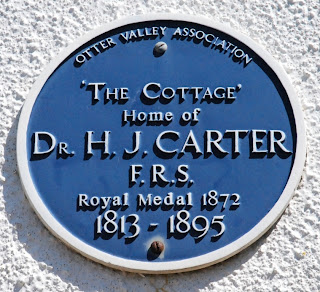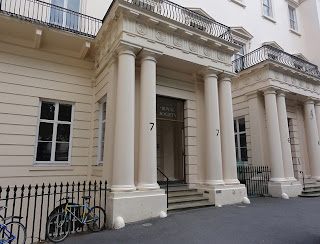An absorbing read
There's always something going on in Budleigh Salterton in spite of what some meanies say. 'Sponge throwing'? Why not? We'd heard it was a charity event involving local dignitaries, and there was even a rumour that one of them would be getting a soaking, standing in the stocks and wearing his regalia.
It was all happening in a local resident's garden with an exhibition set up in a marquee, and bizarrely the day's theme was sponges. Anyway off we went and sure enough there was the dignitary looking pretty wet and bedraggled but smiling away, calling out between sponges "It's all in a good cause! Come on, sponge my face!" Very sporting of him we thought.
The good cause was the Marine Conservation Society, and the
sponge theme was all to do with the bicentenary of the man who used to live in
this charming little cottage on Fore Street Hill. It's called Umbrella Cottage,
apparently because the porch, now thatched, was originally in the shape of an
umbrella.
Henry John Carter was his name as you can see from the blue plaque on the cottage wall, and he turned out to be Budleigh's only home-grown Fellow of the Royal Society, having been born in the town on this very day, 18 August, two hundred years ago and coming back to settle down here when he retired.
Being an FRS is something quite special and exclusive -
reserved for top scientists - I've been told. Well, the Royal Society has a
pretty smart address at No 7, Carlton House Terrace in London
In fact Henry Carter had gained the letters FRS after his name for the work that he'd done in geology during his time as a doctor with the Army in
Henry ended up
writing 1,894 pages in 127 publications on sponges, so certainly deserves his
description as a spongiologist as well as his FRS, which he gained on 9 June
1859. The Royal Society awarded him its Royal Medal in 1872 for what they described as "...his long
continued and valuable researches in zoology, and more especially for his
inquiries into the natural history of the Spongiadae."
Living on the coast in retirement allowed him to carry on spongiologising even on Budleigh beach: in an article published in 1874 he noted a variety of Esperia aegagropila "growing in small patches scantily on the rocks (at Budleigh-Salterton) towards low-water mark."
Now I'd always thought that sponges are rather uninteresting things, just sitting there on the sea bed like seaweed or any other type of marine plant but not doing very much apart from swallowing and regurgitating sea water. But it turns out that they're animals, and there are between 5,000 and 10,000 different species. There are even 150 freshwater species. They also have a quite special sex life, being hermaphrodites, and they come in different shapes and sizes with the tallest reaching two metres in height.
And they're by no means totally useless. This species Rhabdastrella globostellata,
also known as yellow pot sponge, is a marine sponge of the order Astrophorida.
It is native to many regions of the Indian Ocean including the shores of Madagascar , the Seychelles ,
and Australia as well as the
Malayan Peninsula
and Singapore
It may look like something the dog sicked up, but it's has been shown to produce a wide variety of isomalabaricanes, a type of triterpene molecules with notable cytotoxic activity towards certain cancer cell lines.
Sorry, I'm just showing off. I haven't a clue what all those words mean, but they looked pretty impressive in the marquee display.
But it's true that that sponges collected from rock pools by a team from the Welsh School of Pharmacy in south
We
discovered all this when we went into the marquee and saw what they'd done to
remember Henry Carter. There are
even sponges named after him, like this beautiful stylissa carteri orange sponge from Randayan Island , Indonesia
That was when the event organisers had approached Peter MacDonald, Head of Sustainability at the National Fish Board. As he's the son of a much respected Budleigh resident it seemed quite appropriate and apparently he gave them some useful advice. They'd also had help from a big marine laboratory based in
There were a lot of interesting exhibits to do with the
history of fishing in Budleigh and Lyme
Bay Jurassic Coast
But it wasn't just posters and pictures inside the marquee. One wall of the main exhibition was taken up by a gigantic aquarium-full of sponges and other odd-looking marine creatures. A local museum's Natural History section had also helped out by providing marine specimens.
Local art club members had collaborated with the organisers
by staging a display of marine art. The pictures had been selected by a local marine
biologist who's also had some success as an artist. We loved the saucy Joyce
Dennys pictures of mermaids which were apparently done for a mural in the
bathroom of Lion House on Fore Street Hill. A Budleigh art gallery had agreed
to stage an exhibition of prints on a maritime theme and some of those were on
display. A local primary school had organised an art competition to see which
pupils could paint the most amazing sea monsters, and they'd produced some very
imaginative work.
Outside on the lawn a celebrity cook whose name I can't
remember was preparing tempting dishes using some very odd-looking fish that
you don't normally see in fishmongers. There was a display of his books and I
bought one of them which he was kind enough to sign with an inscription to the
'Budleigh Blogger.' I think he was quite intrigued when I told him about my
blog and how it had started, but on reflection he may have just been being
polite. I do tend to rabbit on a bit about my personal obsessions. He seemed
like quite a well-educated and civilised sort of chap so I don't think he'd
have told me to clear off and make way for the next person in the queue.
As it was tea-time we stayed on to watch the sponge cake competition. Not a judging of the best sponge cake but a contest to guess the weight of the biggest sponge-cake I've ever seen. This was a great crowd-puller, almost more popular than the sponge-throwing and people were buying tickets at £1 a go. The top prize for the nearest guess to the correct weight was a day with the celebrity cook working with him in his famous West Country restaurant. I bought a fiver's worth, guessing that the cake was about 30 kilos. I was also hoping that I might get the chance to really explain about the blog and how absolutely everyone should read it.
Clearly I'd under-estimated because the day ended with a speech from the nice celebrity cook asking us to eat more fish with strange names and giving the news that the gigantic sponge-cake had weighed in at 54 kilos.
The event could have ended with a sponge-cake fight, which
my grandchildren would have enjoyed. And the newspaper and TV people who were
there would have loved it. But it would
have been rather wasteful and messy. And of course the seagulls, like this hungry-looking one in the photo, would have
joined in, making things even messier. No, much more sensible was what they did
with the cake, which was to cut it up and send it to local care homes.
The organisers had managed to get the day sponsored by a rather well-known supermarket chain which had opened a branch in the area. With its help and with a lot of hard work on the part of everyone involved a large cheque was sent off to the Marine Conservation Society. I hope it's been used to save a few more whales and coral reefs.
If Henry Carter's spirit is up there swimming around in a heavenly waterworld being sponged gently by Joyce Dennys-type mermaids I'm sure he'd have been tickled and touched by the way that Budleigh Salterton had remembered his life and achievements.
I'm sure also that he'd have approved this gesture on the part of a small coastal town to acknowledge the debt that it's owed to the sea for its livelihood over so many centuries.
This post is a link from http://www.devonmuseums.net/A-wholly-absorbing-daydream/Latest-News/Fairlynch-Museum/Museum-News/














Comments
Post a Comment